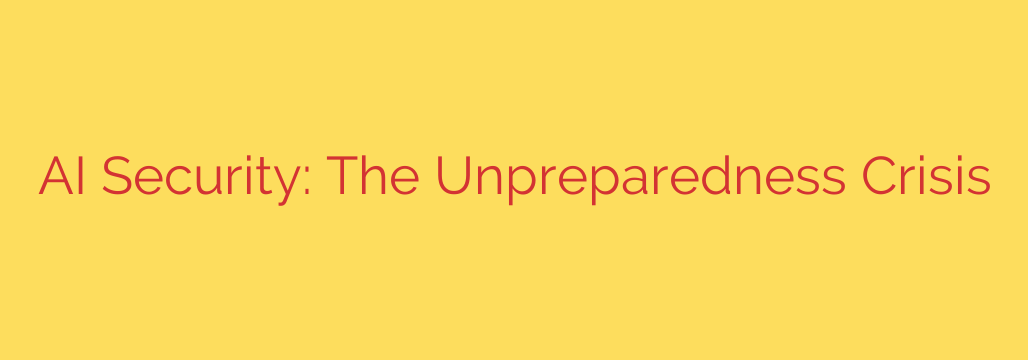
The Hidden Dangers of AI: Why Your Security Strategy is Already Outdated
Artificial intelligence is no longer a futuristic concept; it’s a foundational technology reshaping industries, from automating customer service to powering complex financial models. Businesses are racing to integrate AI to gain a competitive edge, but in this rush, a critical blind spot has emerged: security. The very nature of AI introduces a new class of threats that traditional cybersecurity measures are ill-equipped to handle, leaving many organizations dangerously unprepared.
The core of the problem lies in a fundamental misunderstanding. We often treat AI models like any other piece of software, but they are fundamentally different. Their ability to learn, adapt, and make autonomous decisions also makes them vulnerable in ways we’ve never seen before. Companies are deploying powerful AI systems without a corresponding strategy to secure them, creating a ticking time bomb in their technology stack.
The New Frontier of Risk: Understanding AI-Specific Threats
Securing an AI system goes far beyond patching software or monitoring network traffic. The attacks are more subtle, targeting the logic and data that form the AI’s “brain.” To protect your assets, you must first understand this new threat landscape.
Key vulnerabilities include:
- Prompt Injection: This is one of the most common attacks against large language models (LLMs) like those powering generative AI. An attacker crafts a malicious input (a prompt) that tricks the AI into bypassing its safety protocols. This can force the model to reveal sensitive information, generate harmful content, or even execute unauthorized commands within a connected system.
- Data Poisoning: An AI model is only as good as the data it’s trained on. In a data poisoning attack, malicious actors intentionally feed corrupted or biased data into the model during its training phase. The result is a compromised model that may appear to function normally but will produce flawed, biased, or insecure outputs that can go undetected for months, leading to catastrophic business decisions.
- Model Evasion and Extraction: Attackers are developing sophisticated techniques to probe and exploit AI models. Evasion attacks involve crafting inputs that are designed to be misclassified, allowing malicious content (like malware or spam) to bypass AI-powered security filters. Even more concerning are extraction attacks, where an adversary can effectively steal the AI model itself—or the sensitive proprietary data it was trained on—by repeatedly querying it and analyzing the responses.
Why Traditional Security Is Falling Behind
Your existing cybersecurity infrastructure is essential, but it is not enough to counter these new threats. Traditional firewalls and antivirus software are simply not designed to detect a maliciously crafted prompt or poisoned training data. These tools look for known malware signatures and suspicious network behavior, whereas AI attacks exploit the inherent logic and learning processes of the model.
This new paradigm requires a shift in mindset. Security teams must move from solely protecting the perimeter to also securing the model’s core, its data pipelines, and its decision-making process. Without this evolution, your organization is essentially leaving its most advanced digital assets unguarded.
Building a Resilient AI Security Strategy: Actionable Steps
Protecting against AI-driven threats requires a proactive and multi-layered approach. Waiting for an incident to occur is not an option. Forward-thinking organizations should begin implementing a robust AI security framework immediately.
Here are essential steps to secure your AI initiatives:
- Embrace a Security-First Mindset for AI: Security cannot be an afterthought. Involve your cybersecurity team from the very beginning of any AI development or procurement process. Conduct thorough risk assessments specifically for AI models, identifying potential vulnerabilities before they are deployed.
- Vet Your Data and Models: Scrutinize the sources of your training data. Ensure data integrity and implement processes to detect and filter out anomalies that could indicate a poisoning attempt. If using third-party models, demand transparency from vendors about their security practices and the data they used for training.
- Implement Robust Monitoring and Guardrails: You need real-time visibility into how your AI is being used. Deploy specialized tools that can monitor the inputs (prompts) and outputs of your models to detect suspicious patterns indicative of an attack. Establish strict “guardrails” that limit what the AI is authorized to do, preventing a successful prompt injection from causing widespread damage.
- Train Your People, Not Just Your Models: The human element remains a critical line of defense. Educate your employees—from developers to end-users—on the risks of AI security, including how to recognize and avoid crafting prompts that could be manipulated.
- Develop a Specific AI Incident Response Plan: When an AI security breach occurs, the response will be different from a traditional cyberattack. Your incident response plan must include procedures for retraining a poisoned model, isolating a compromised system, and communicating the impact of a decision made by a faulty AI.
The integration of artificial intelligence offers immense opportunities, but it also opens a new front in the battle for cybersecurity. Ignoring these unique risks is a gamble no business can afford to take. By understanding the threats and taking decisive, proactive steps to build a resilient security posture, you can innovate with confidence and ensure your AI serves as a powerful asset, not a critical vulnerability.
Source: https://www.helpnetsecurity.com/2025/08/20/jacob-ideskog-curity-ai-agents-threat/








